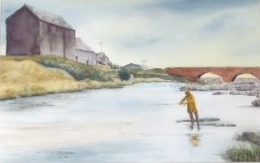“Perhaps the greatest psychological, spiritual, and medical need that all people have is the need for hope.” — Billy Graham
When you hear a song, view a painting, or read a story don’t you want to be moved? Don’t you want your experience to be worthwhile—to understand a new truth about life or have one confirmed? Receive an ah-ha that changes your life for the better? Isn’t that part of the entertainment you expect?
Let’s look at the three elements a creative work must have to stir hope and renewal.
3 Elements to Stir Hope and Renewal
1. The Creative Work Must Give a Hint of a Basic Need.
In one of my mom’s paintings, a fisherman, dressed in a muted yellow rain slicker and boots, stands in a river, his fishing pole extended. The glassy water reflects a sunless sky. Gray stone buildings stand tall and sturdy on one bank. Down the river a brown bridge constructed of brick arches spans the river.
The possible needs hinted are:
- Food source
- Protection from the weather
- Sturdy shelter
- Rain for the earth
- A way to cross the river
- Solitude to renew one’s spirit
These needs draw me into the picture. I want to go inside the buildings and hope a fire blazes against the damp day. I hope and want to see the fisherman catch a fish to take home. I want to walk across the bridge and look down into the water.
2. The Creative Work Must Give Glimpses of Good and of Hope
In the story I’m writing, a young woman has put herself in a predicament because of her reaction to a deep hurt she’s experienced. Among all the obstacles and setbacks to overcome her mess, I show glimpses of how she can heal and become whole again, even if at some points she’s not ready yet to make the right choices.
The painting of the fisherman gives a glimpse he can provide food for his family. His slicker and boots keep him dry. He may be renewing his spirit in his solitude. God has provided rain for the nourishment of his surroundings.
3. The Creative Work Must Satisfy Within the Realm of Reality
The painting didn’t show the fisherman catching a fish, but we know it’s possible, and that’s satisfying. The day is overcast, but we know the earth needs rain and the sun will shine again.
A story may have an unhappy ending. But if the choices the main character makes shows the ending is the only one likely without a miracle, the ending can be satisfying to most people. Such a story may move readers to make better decisions or raise their children to make good choices.
Personally, I prefer a story that shows us how the character overcomes obstacles and gives us ways to improve others’ and our lives. For me, the overcoming includes a growing faith and trust in God.
A creative work can renew us when it shows a need, glimpses of what is good in relation to the need, and leaves us with a measure of realistic hope and renewal.
What have you seen in a creative work that was behind the hope and renewal you experienced?






 RSS - Posts
RSS - Posts
In Nancy Rue and Stephen Arterburn’s Sullivan Crisp novels, Healing Stones, Healing Waters, and Healing Sands, I saw God using writing creativity and psychology expertise to bring hope and renewal. Each book creates an initially repulsive character: an adulteress, a fat compulsive eater and someone who rages. The novels help us understand why someone would commit adultery, binge when they are overweight and continue to rage when they’ve hurt the people they love. We cheer for the main characters when they begin to understand themselves. The hope and renewal these books demonstrate makes me want to be more sympathetic; more understanding of people, I think should change, and am more open to risking change myself.
Now I’m going to look for hope and renewal in the artwork hanging on my walls. Thanks Zoe
I’m going to have to check those out, Marcia. If novels help us to understand people better, judge them less, and love them more, we can be part of their success story—and our own.
Zoe… in looking back at things I’ve read that have given me hope and renewal (especially in my youth), I would have to say they always included something of lifestyle, relationships, or locations that I was initially drawn to in the first place. There seemed to be some comfort in escaping to a place where things were like they ought to be, rather than the confusion of the world around me. That isn’t to say the stories didn’t have their heroes and villains along with their various tragedies and triumphs. But everything came out RIGHT in those well-ordered worlds.
The “ah-ha” came in seeing how the characters handled (or mishandled) such things, and learning from them in ways that could be applied to my own life. The miracle is that many of them actually worked, making up for the lack of such “guidance” in my real life. The realization that one could get so much valuable “treasure” from good books made me a lifetime fan. Which I still am.
Wonderful subject… one of my favorites!
Thanks Lilly, for relating what you experienced. Books often offer a place and life that we can escape into. I suppose depending on the story, we can be glad we have it so good, or we can have hope that things can be RIGHT as you say. I think I’ve experienced some of both. Enjoyed your book, Gold Trap.
Yes, I think “book worlds” make more sense (good, or bad) simply because authors have striven to paint a particular picture–like your mother’s painting (beautiful!)– in order to present their ideas. So, the why’s and how’s are clearer. The remarkable thing is that readers can almost feel those experiences as their own if they identify with them strongly enough. Which then provides fertile ground for those “seeds of hope and renewal” to be planted in their own hearts, as well as the characters they are reading about. Hmm… sounds almost like a God thing.
Which is why I like to call some fictional characters “gentle missionaries.” Because they never correct or criticize, but merely live out the silent witness of their lives within the boundaries of their own particular story. And considering it takes several hours (if not days) to read a book, not many of us ever give that much undivided attention to people in the real world. Something that leads me to believe writing books has to be one of the most far-reaching professions around.
Oh, yes, and I’m tickled you liked GOLD TRAP… thanks so much for reading it!
Like the “gentle missionaries” label. I thought about my own story in progress and have two I’d consider gentle missionaries. Thanks, Lilly.
It’s great how you used the painting to explain the lesson. I agree, overcoming obstacles takes faith in our Lord. Without Him, I think the end result would be hollow.
When I was thinking about the blog post, I looked up and saw my mom’s painting. As I looked at it, I wondered why it spoke to me. Hollow is a good word. I depend on the Lord in all my obstacles.